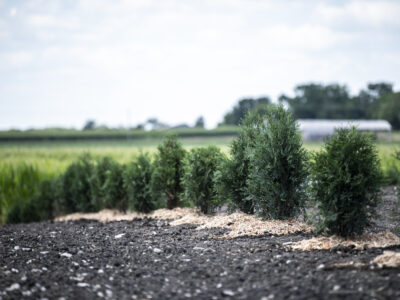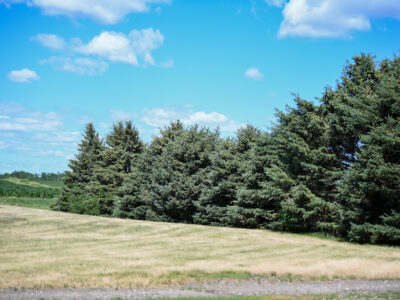What Makes a Good Windbreak?
02-08-2016 in Green Farmstead Partner
Planting a windbreak at your livestock facility site can enhance protection from Iowa’s winds and snow, and also improve relations with your neighbors.
“If you can’t see it, you can’t smell it,” says CSIF Field Representative Kent Mowrer. It’s true. Iowa State University research shows trees can reduce odor by 10-15 percent by capturing dust and odor particles and directing airflow.
A windbreak can also lend aesthetic value to the site, providing a picturesque screen that reduces the visual impact of the livestock operation.
Windbreaks also offer weather protection. Using a well-designed windbreak can reduce snow removal time and expense by channeling snow into desired areas, and can reduce heating and cooling costs for the livestock unit by providing shade and directing air flow. For the best protection, a windbreak should be planted perpendicular to the prevailing winter winds – the north and west for Iowa farmers.
But establishing an effective windbreak is not as easy as simply planting trees. It requires a knowledgeable and detailed design directed by a professional landscaper to provide the desired protection and visual effect. For instance, a distance of at least 75 feet should be maintained between the trees and buildings to provide proper ventilation, and to allow adequate room for snow deposition.
In the landscaper’s hands, the options are many. CSIF’s Green Farmstead Partner program can help steer that effort. At a January 26 conference for landscape professionals hosted by CSIF, Brad Riphagen of Trees Forever highlighted viable design and species possibilities.
“It’s important to get the right plant in the right place for the right purpose,” said Riphagen.
Windbreaks are generally planted with a mix of tall trees and shrubs. Hybrid willows are one of the most popular trees – they are fast growing and reach a mature height of around 50 feet.
A traditional multi-row windbreak design is comprised of three or more rows of vegetation, at least one of which is densely planted conifers. Spacing between rows is typically 12-16 feet to accommodate windbreak maintenance equipment.
Popular shrubs used in Midwest windbreaks include Arrowwood Viburnum and several varieties of Dogwood. Shrubs not only offer ground level protection from blowing snow, but can increase the windbreaks’ role in providing wildlife habitat. Colorful varieties can also provide added aesthetic appeal.
A twin row, high-density design places rows closer together, and plants closer within the row. The design allows for greater density within a shorter timespan and less weed control maintenance between rows.
Some landscapers and producers like a combination of the two, with a twin row of closely spaced shrubs 50 feet from the windward side of a multi-row break of taller trees acting as a snow trap.
Riphagen emphasized the potential for the windbreak as part of the farm’s sustainability plan, utilizing agroforestry species in the design. A variety of nuts have market potential. Walnuts, pecans, and hazelnuts are popular species. Berries like the popular aronia berries or elderberries can yield farm income once established, and classic fruit trees or Christmas trees are always an option.
Riphagen added in lieu of shrubs, producers might want to consider planting native prairie grasses and forbs. Such plants are specifically suited to Iowa, can be visually appealing, and create wildlife habitat.
A host of resources abound to help plan your windbreak – through Trees Forever or the Coalition to Support Iowa’s Farmers. And be sure to consult your landscape professional to reap the best benefits from your effort. CSIF provides a list of participating nurseries on its website.
By Terri Queck-Matzie for CSIF
Recommended News

Growing the Ag Environment
Ryan and Lana Reed of Wapello County spent an almost-spring-like March day tending to the windbreak near two of their hog barns. Planted in 2010, the fast-growing austree hybrid willow...
Read More
Ames Landscaper Joins Green Farmstead Partner Program
West Des Moines, Iowa – April 4, 2023 — Landscape Legends of Ames has been designated a participating landscape professional in the Coalition to Support Iowa’s Farmers’ (CSIF) Green Farmstead...
Read More
Derecho Brings Opportunity for Story County Family
Brian Sampson of Story County is an optimist. “I like to be around people who think most things are possible,” says Sampson. When the derecho rolled through his farm last...
Read More